student label project
In 2021, students enrolled in ARTH 324: Canadian Art and Cultural Identity, selected artwork from the President’s Art Collection for an artwork research assignment. With support from the Curator, they researched and wrote the following extended label texts.
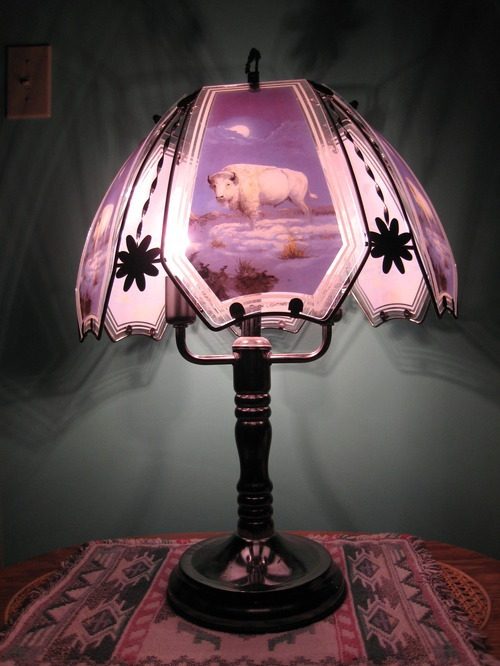
Dana Claxton (b. 1959)
The Sioux, 2010
C-print on archival paper
University of Regina President’s Art Collection; pc.2015.04
© Dana Claxton. Reproduced with the permission of the artist. Photograph by the artist.
Dana Claxton (1959-present) was born in Yorkton, Saskatchewan, as a Hunkpapa Lakota. Being closely knit to the intangible heritage of her family, her upbringing in the Wood Mountain Lakota First Nation became her inspiration to create artwork that reflects her own values and beliefs. In 2010, while visiting her aunt’s house in Standing Buffalo, her camera captured a jewel: a photograph of a lamp with rose-tinted leaves and a sleek black trunk, titled Sioux Lamp #3. Its signature is the image of a bison on each symmetrical shard of the lampshade.
This artwork reflects how the bison – a majestic species whose numbers have
dwindled due to loss of land and other factors – transcends beyond the realm of reality. Its aura induces a trance-like state: imaginations of bison roaming freely in an open field. The lamp shines bright as if the image can breathe heavy breaths and roam freely in an open field. In this still life, the bison is loved, respected, and treated with equality.
Claxton combines beautiful twilight colours with a black-and-white background to create a beautiful miniature sunset. The hues of purple in the lamp’s shades mirror the brilliant patterns of the hand-woven tablecloth: a pedestal for the lamp. It represents hope for a better future. Literally, a light in the darkness.
The inspiration for Claxton’s work is a duality. On one hand, she utilizes her love for the culture and values of Indigenous people. On the other hand, decolonization and reconciliation are topics that are close to Claxton’s heart. Throughout her long career as an artist and an academic, Claxton continues to be a shining light for social justice. For her work, she has received several awards, including an Eiteljorg Fellowship award, a YWCA Women of Distinction award, and the Governor General’s Award in Visual and Media Arts.
Janelle Araquel
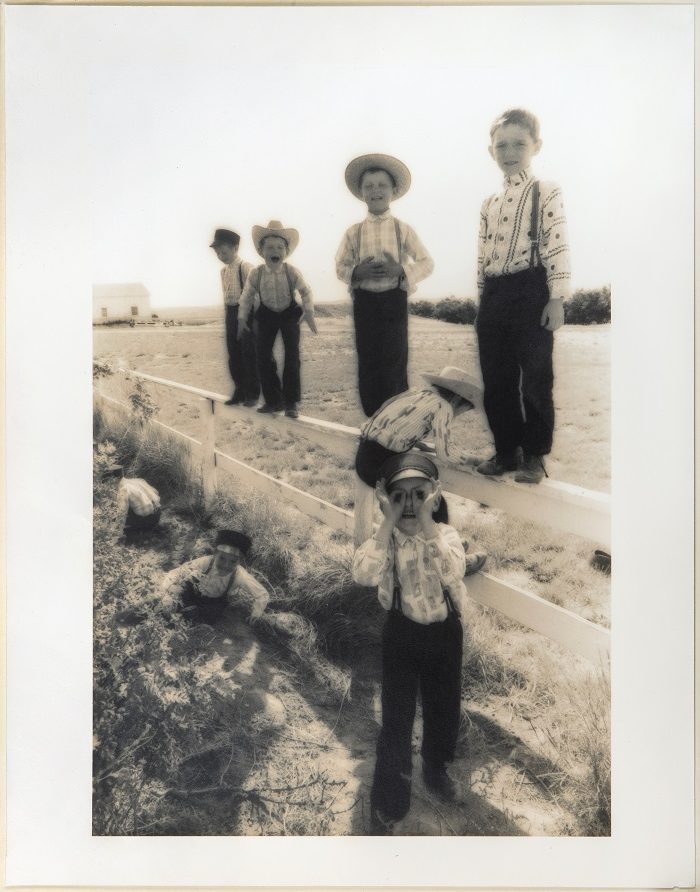
Daniel Kazimierski (1925-1983)
Glidden Colony (or Hutterite No. 16), 1976
Sepia-toned gelatin silver print
14″ x 11″
University of Regina President’s Art Collection. Gift of Bernard Mulaire, 2019; pc.2019.04
© Daniel Kazimierski. Reproduced with the permission of the artist. Photograph by the University of Regina.
Daniel Kazimierski (b.1949) is a Polish American Photographer from Warsaw, Poland. Who currently resides in Piermont, New York, United States and Cape Breton, Nova Scotia, Canada. He studied photography and film at several academic institutions, including The Vancouver School of Art, York University, University of Toronto and New York University.
I was fortunate to have the opportunity to interview Kazimierski via email in November of 2021. He was candid and honest in his responses, as he recalled memories of what it was like to document his time with the Glidden Colony. The photo was taken in 1976 while he was a student at The Vancouver School of Art; he had taken a road trip across Canada and had met up with a local farmer who introduced him to the colony. He described how initially the colony members were hesitant to have their photos taken for religious reasons. He stated that after some time had passed. A Hutterite couple had asked him to take a photo of them in front of their house. And from there other members of the colony were eager to have their photo taken.
I asked Kazimierski if he could recall the moment he took the photo of the children in Hutterite No.16. I was surprised to learn how much he could recall; as he described the interaction he had with the children. He said that the children began following him around and became curious in his camera, as they posed for him on the fence. Kazimierski recalled that the boy who made the face had noticed that Kazimierski had been wearing glasses and had playfully mocked him. Kazimerski admitted that one of his favourite moments of the interaction was when one of children had asked about the camera equipment he was holding and the boy asked “How heavy am I?” Kazimerski remarked how endearing this observation was, and states how he never forgot it.
E. Kulbida
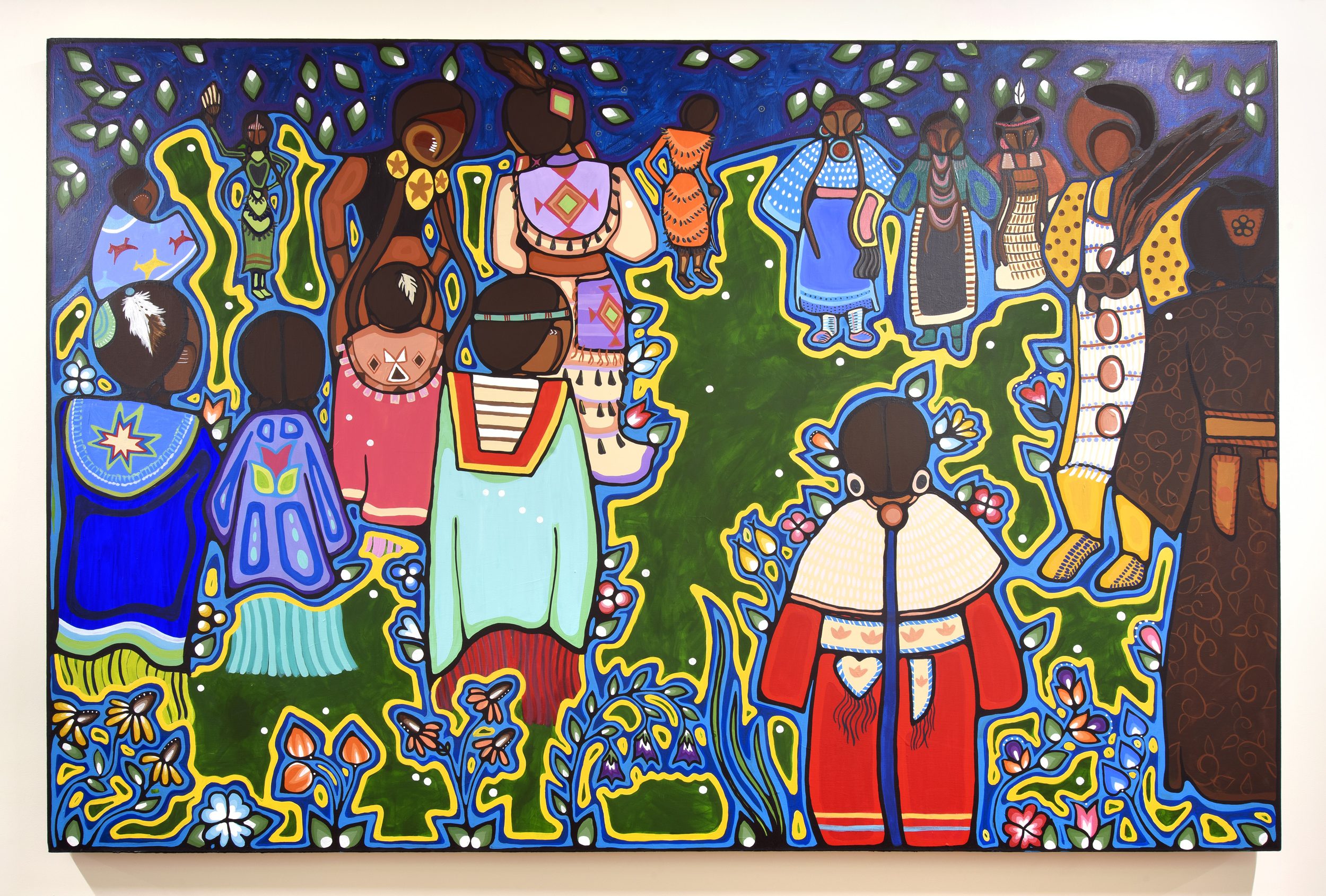
Larissa Kitchemonia
Saturday Night Pow Wow, 2019
Acrylic on canvas
61 1/2″ x 91.8″
University of Regina President’s Art Collection; pc.2019.02. © Larissa Kitchemonia. Reproduced with the permission of the artist. Photograph by the University of Regina.
Larissa Kitchemonia is a mother, artist, and lifelong learner from The Key First Nation, attending the First Nations University of Canada as a graduate student and sessional. Art is her compulsion; her ideas regurgitate as an artform. She is humble about her practice although takes pride in her identity. She explores constructs of indigeneity, femininity, and decolonization as integral aspects of her worldview. She advocates for Indigenous presence in North American visual culture. Her deliberate creations are respective of her cultural protocols and actively confronts and compels viewers to process Indigenous occupation by how the physical and pictorial space is demanded. The colours of her palette are endless, with her canvas being the world. She brings stories of her people to life through her practice and studies, ultimately elevating Indigenous knowledge. “It’s really important to me that people look at my artwork and they know that it’s Indigenous,” (Kitchemonia, 2018).
By painting intuitively, Kitchemonia combines the compositional aspects of abstraction and alternative structures with her most common motifs of feminine and Indigenous florals and intentionally vague human figures. Saturday Night Pow Wow (2019) was made for the exhibition, Anuhkimo! Make Them Dance! (2019), with the cohesive thought being, “Pow Wow as a celebration of Indigenous identity,” (Kitchemonia, 2021). Because Saturday night is the main event of a powwow, this painting was created monumental in size. The dancers are depicted with the three styles of Fancy Shawl, Jingle, and Traditional who are young, old, contemporary, and old-style. Flowers, colours, lines, and dots embody the sacred and the secular of her subject matter. The arbor is shaded with the freshly cut branches illustrated by the leaves scattered across the night skyline. The dots and the electrifying yellow and blue contour lines express that of the immaterial.
Brianna Laplante

Marielouise Kreyes (1925-1983)
Man I, 1972
Acrylic on canvas
55″ x 38.75″
University of Regina President’s Art Collection, Shumiatcher Donation. Gift of Dr. Morris C. Shumiatcher, O.C., S.O.M., Q.C. and Dr. Jacqui Clay Shumiatcher, S.O.M., C.M., 2016; sc.2016.108
Marielouise Kreyes was born in Germany around 1925 and came to settle in Canada in 1951. She had studied art at the University of Manitoba and later got her degree in 1963. Just when acrylic paintings and photo realism were at the height of popularity, Kreyes created Man I before passing away in 1983.
The painting is acrylic on canvas, showing a man’s backside with mousey brown hair, a yellow crinkled dress shirt, and some grey slacks. He is staring out a window with a view of dead winter trees in front of a white building. There is nothing in the room with the man except for a white side table and his thoughts. The colours Kreyes used are very cool tone. With lots of greys and ashy greens the colours add on a sense of darkness that not even the man’s yellow shirt can light up.
Wintertime can be a difficult time for some people, especially in the prairies. Kreyes created this painting in the 1970s and it still very much resembles what a winter’s day looks like in 2020. The year of the pandemic and quarantining took a lot out of people, and there were some days where all one could do was just stare out their window. It is interesting to see different periods paint the future without even realizing it.
Jiness Helland
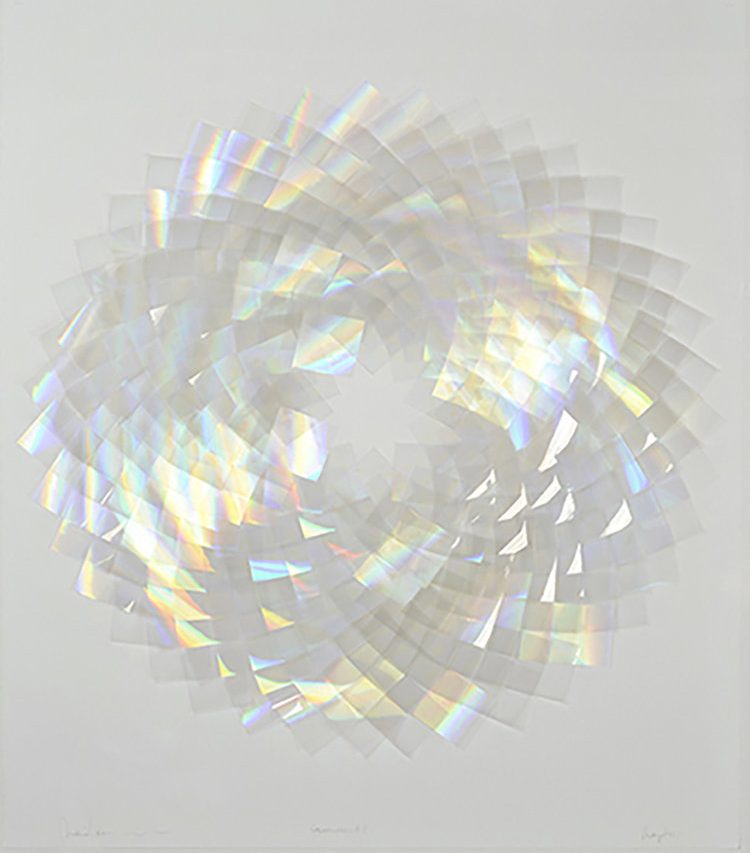
Marie Lannoo (b. 1954)
Colour Wheel #8 (2011)
Mylar on stonehenge paper
41 1/2″ x 35 1/2″
University of Regina President’s Art Collection; pc.2016.09
© Marie Lannoo. Reproduced with the permission of the artist.
Marie Lannoo is a Saskatoon-based visual artist interested in the architecture of colour. Influenced by the history of abstraction and modernism, she blurs the line between scientific research and artistic expression (Nasgaard).
Lannoo creates works that form a contemplative experience and that transform the viewer into a sensorimotor organ (University of Saskatchewan). Referencing the principle that colours exist only because of the way light interacts with and reflects off of materials before being perceived by the eye, Lannoo creates immaterial colour experiences by breaking colours down into wavelengths, and blurring the line between material and immaterial (Zurevinski).
Colour Wheel #8 is typical of her work, creating subtle prismatic colours, a shifting ethereal rainbow on blank paper. It subverts the concrete idea of a colour wheel as a tool, and transforms the wheel into a prismatic shift. It’s a piece that’s reflective of Lannoo’s interest in and research into structural colour, and the science behind how light interacts with mediums to create our experience of colours.
Beyond its shimmering, ungraspable beauty, Marie Lannoo’s work represents one artist’s journey to explain and recreate her individual, intangible understanding of colour. Colour Wheel #8 brings us into this space of contemplation, and allows us to see what Lannoo sees
when she conceptualizes and experiments with colour. It’s spectral immediacy is both beautiful and thought provoking, and it’s presence in the University of Regina’s presidential collection is well earned.
Dela Collins
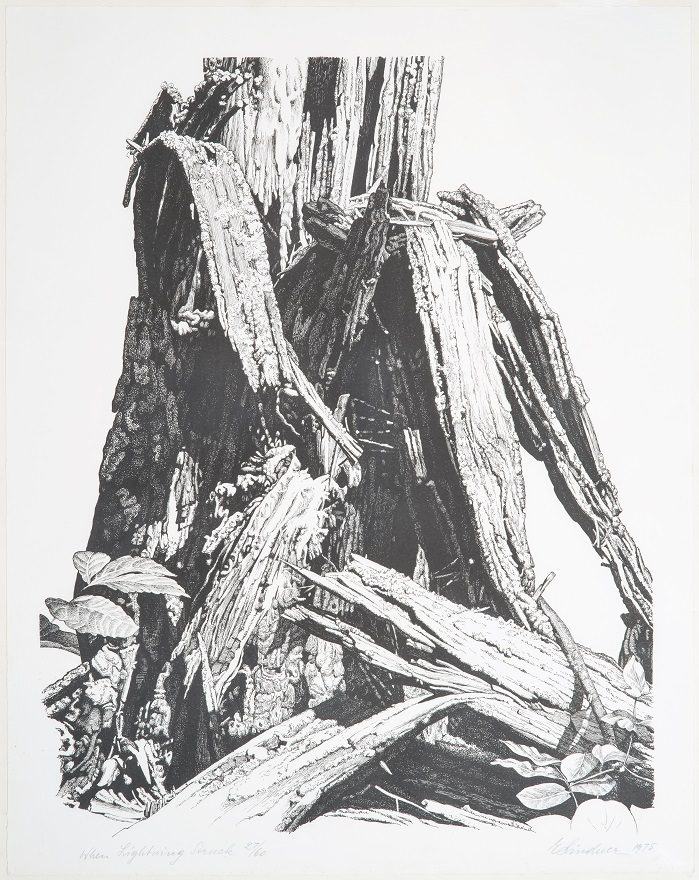
Ernest Lindner (1897-1988)
When Lightning Struck (27/60), 1975
Lithograph
20″ x 25″
University of Regina President’s Art Collection; pc.120
© Ernest Lindner. Copyright Visual Arts-CARCC, 2021
Artist and educator Ernest Lindner settled in Saskatoon, Saskatchewan after immigrating from his home country of Austria to find work in 1926. Lindner quickly became known in Saskatoon for his modernist watercolor paintings that depicted the arboreal forest landscape near his Emma Lake home, which later became an Artists’ Workshop in the 1960s that was run by the University of Saskatchewan. When Lightning Struck, a print using photo lithography, was a work that Lindner created later in his career in an attempt to show nature’s constant change and growth.
Drawing on his inspiration in Northern Saskatchewan plant life, Lindner added to his theme of the cycle of life, and the beauty found in the texture and details of nature. When Lightning Struck was a change from Lindner’s popular drawings and paintings, but with photo lithography he was able to capture closeups of his subjects and capture details with a camera that he couldn’t achieve with paint. With this print Lindner tried to bring across his ideas of life continuity and his belief that death is another form of life.
Lindner was a major part of the Saskatoon art scene throughout his career. In the 1930s he created “Saturday Nights”, a weekly discussion group with members of the local art community. He was a member and President of the Saskatoon Art Association from 1933 to 1964, and he also taught drawing and painting at the Saskatoon Technical Collegiate. His work has been shown internationally and throughout Canada with much acclaim. Ernest Lindner has had a huge influence on Saskatchewan artists, and had a school named after him in Saskatoon in 2017.
Sheldon Brown
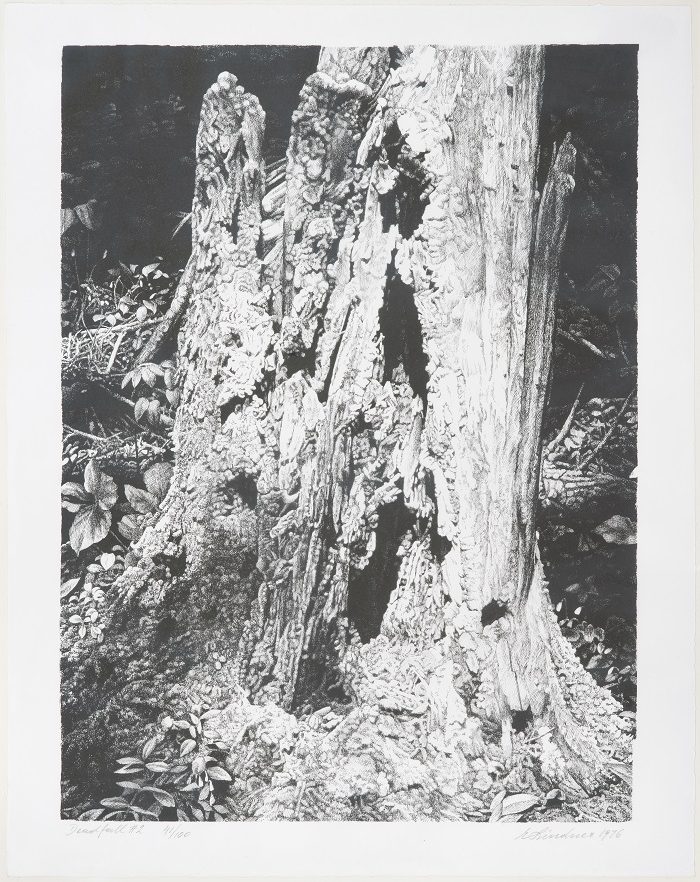
Ernest Lindner (1897-1988)
Dead Fall #2 (41/100), 1976
Lithograph
25″ x 20″
University of Regina President’s Art Collection; pc.118
© Ernest Lindner. Copyright Visual Arts-CARCC, 2021
Dead Fall #2 (41/100) is part of a limited series of lithographs produced at the University of Regina from Ernest Lindner’s original pen and ink drawing. Dead Fall #2 is an example of Lindner’s unique perspective on Saskatchewan’s northern landscape. In this series, Lindner explores a familiar theme: nature’s life cycle. The focal point is the decaying stump of an undetermined tree set against a background and a foreground that hints at regeneration and new growth. Although the tree is in a state of decay, the image projects movement and life. This piece is an example of Lindner’s later works, which feature close-ups of Saskatchewan’s northern forests. These later works were influenced by mentor and friend Clement Greenberg, who advised Lindner to focus on the subject that he wanted to paint and avoid unnecessary fillers.1
Lindner was born in Vienna, Austria in 1897, immigrated to Canada in 1926, and lived in Saskatchewan until his death at the age of 91. Lindner is an important figure in Saskatchewan’s art community and history. He created and taught art for over 60 years. For decades, he participated in the influential Emma Lake artist retreats. Lindner’s works have been shown locally and internationally since the 1940s, including Vienna’s Academy of Applied Art , Grand Central Galleries in New York City, the Royal Ontario Museum, and the Art Gallery of Ontario. In 1972, Lindner was awarded an honorary Doctor of Laws degree from the University of Saskatchewan. He was an elected a member of the Royal Canadian Academy of the Arts in 1977 and received the Order of Canada in 1979. In 1988, he was awarded the Saskatchewan Arts Board’s Lifetime Award for Excellence in the Arts.
1 In 1962, at an Emma Lake artist workshop, Clement Greenberg advised Lindner “to concentrate on the subjects he was interested in and forget about filling in the backgrounds and trying to line up the perspectives…[and to] remain inside the picture.” Terrance Heath, Uprooted: The Life and Art of Ernest Lindner, (Saskatoon: Fifth House, 1983), 138.
Lara D. Stoudt

Zachari Logan (b. 1980)
Daphne, from the Eunuch Tapestry series, 2012
Pastel on black paper
38″ x 38″
University of Regina President’s Art Collection. Gift of Zachari Logan, 2018; pc.2018.08
Zachari Logan works in large-scale drawings, ceramics, and installation artwork. His research explores the intersections between masculinity, identity, memory, and place. Logan often mixes plant, animal and human parts in seamless and often natural looking compositions to create assemblages that are both queer and natural. This is a strategy that Logan uses to emphasize that humans are part of nature, and that within nature both form and sexuality occur as a spectrum.[1]
Though roughly life-sized, Daphne is tiny compared to its panoramic neighbours in the Eunuch Tapestry series. This choice, along with the roundel shape, gives the impression of looking through a keyhole. This circular drawing is comprised of an elongated neck emerging from dense foliage, culminating in a bearded man’s head shown in profile. The skin has a mottled, translucent quality, displaying a full range of blushing reds, bruised blues, and sickly greens.
Each part of the drawing is rendered in sharp, meticulous detail. The composition of the foliage is reminiscent of a floral arrangement in the Dutch still life tradition, in that the plants represented are a mixture from different regions and seasons, and carry symbolic meaning. “If I recall it was a mixture of foliage, some accurately depicted from nature mixed with hybridized and more generalized forms of flora… essentially creating a magical, somewhat internalized depiction of the landscape.”[2] Computer imaging identifies one species in the underbrush as: Shrub Balsum (Impatiens Sodenii).[3] It is cultivated in ornamental gardens, but has escaped captivity in New Zealand and become an invasive species, a pernicious weed there. It occupies a liminal space between tame and wild, wanted and unwanted.
Logan explains the title “is a reference to the story of ‘Daphne’, but with my likeness and use of flora.”[4] Daphne is a Greek myth about a nymph who rejects the love of Apollo; and can only escape his advances by transforming into a laurel tree. She is also liminal, a hybrid between human and plant. By inserting his own image into the narrative of Daphne, Logan draws a parallel, asserting his identity as liminal and queer.
Daphne is part of a series entitled The Eunuch Tapestry. This title is a pun on the Hunt of the Unicorn; a series of Medieval tapestries depicting the capture of the eponymous mythical beast, representing a religious quest of healing and sexual purity. This is subverted by the wordplay changing “unicorn” to “eunuch,” suggesting castration and the debilitating effect of social repression on queer lives.[5]
Bio (From Dunlop Art Gallery Website)
Zachari Logan (born 1980 – ) Born in Saskatoon, Zachari Logan earned his BFA (2006) and MFA(2008) at the University of Saskatchewan. Logan works in drawing, ceramics and installation practices, and has collaborated with renowned artists such as Ross Bleckner, and Sophie Calle. Though currently based in Regina, artist residencies form an important part of Logan’s practice, and he has been awarded several prestigious international residencies in Vienna (Austria), New York and rural Tennessee (USA), Paris (France), and with the McMichael collection in Ontario. In 2014, Logan was awarded the Saskatchewan Lieutenant Governor’s Award for Emerging Artist, and in 2015, the Alumni of Influence Award from the University of Saskatchewan.[6]
William Bessai-Saul
[1] “Zachari Logan,” Dunlop Art Gallery, accessed November 16, 2021, http://collection.dunlopartgallery.org
[2] Zachari Logan (artist), Instagram message to author, 10:26 PM, November 13, 2021
[3]“Impatiens sodenii Engl. & Warb.,” Pl@ntNet, accessed November 16, 2021, https://identify.plantnet.org/the-plant-list/species/Impatiens%20sodenii%20Engl.%20%26%20Warb./data
[4]Zachari Logan (artist), Instagram message to author, 10:26 PM, November 13, 2021.
[5]Margaret Bessai, Zachari Logan: A Natural History of Unnatural Things (Regina: Art Gallery of Regina, 2015), p. 3.
[6]“Zachari Logan,” Dunlop Art Gallery, accessed November 16, 2021, http://collection.dunlopartgallery.org

Zachari Logan (b. 1980)
Foot Rest, 2015
Clay, found object
18″ x 22″ x 12 1/3″
University of Regina President’s Art Collection. Gift of Zachari Logan, 2018; pc.2018.07
Saskatoon-born artist Zachari Logan (b.1980) works primarily in drawing, ceramics and installation. Logan’s work has been exhibited both nationally and internationally. In 2014 he received the Lieutenant Government General Award and was long listed for the Sobey Art Award
in 2016. Logan’s meditative and detailed work evokes nature’s ability to refresh and replenish both the body and mind, reflecting on the role of nature as an essential element in exploring self-identity. Botanical motifs are a signature in Logan’s work. Logan often draws inspiration
from his hometown’s ditches rife with weeds and tangled hordes of fauna. Logan casts Saskatoon ditches as a metaphor for the LGBTQ+ community. Much like the fauna lining dirt roads and highways, the LGBTQ+ community is no stranger to feeling on the outskirts of a society. However, resilience and growth continue to flourish in the face of a sometimes unforgiving environment.
Foot Rest combines a wooden foot rest with the incorporation of clay sculpture. The base is replaced by a bed of carefully sculpted plants, while the decorative wooden legs remain unchanged. Logan snathces some inspiration from the prairie ditches, incorporating familiar plants such as cattails into the piece. Logan’s sculpture deconstructs the foot rest, playfully calling into question the functionality of the object. By combining imagery of nature with a domestic object, Logan incorporates flora into the everyday while demonstrating his profound connectedness to nature. The clay is left unpainted revealing the soft off-white colouring. The absence of any glaze allows for the brittle and matte texture to remain uncovered. Logan likens both the colour and texture to bone, further cementing the relationship between human and nature.
Sage Wosminity
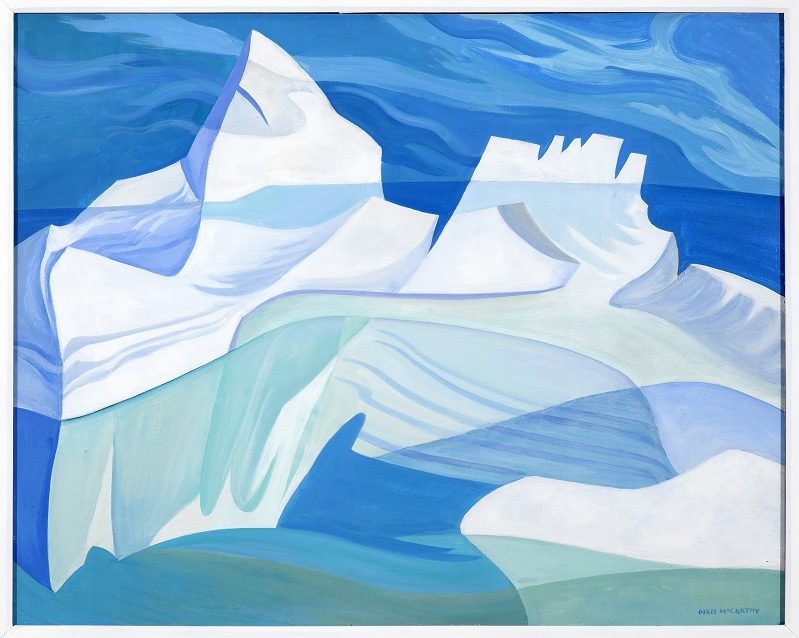
Doris McCarthy (1910-2010)
Iceberg Fantasy #2, 1972
Oil on masonite
32 ¼” x 38“
University of Regina President’s Art Collection, Shumiatcher Donation. Gift of Dr. Morris C. Shumiatcher, O.C., S.O.M., Q.C. and Dr. Jacqui Clay Shumiatcher, S.O.M., C.M., 2019; sc.2019.104
© Doris McCarthy. Photograph by the University of Regina. Reproduced with permission.
“You are actually constructing… what your head understood about what your eyes saw.” – Doris McCarthy[1]
Canadian artist Doris Jean McCarthy (1910-2010) was born and raised in Calgary, Alberta before moving in 1913 to Toronto, Ontario where she remained for the continuation of her life.[2]McCarthy’s extensive art career began in 1925 when she studied at the Ontario College of Art. During her education McCarthy was inspired by her mentors and Group of Seven members J.E.H MacDonald and Arthur Lismer while developing her own unique style. After graduating McCarthy would teach at the Toronto Central Technical School and continued to spread her love of art through teaching and inspiring generations of young artists.[3] McCarthy explored various styles such as expressionism, abstract expressionism, and a minimalistic colour-edge painting. Fueled by a love of traveling, McCarthy painted scenes from across the globe such as Costa Rica, Spain, Italy, Japan, India, England, and Ireland. [4] McCarthy’s love of traveling would result in her first trip to the Arctic in 1972 and later lead to nearly annual trips back influencing a large collection of her works.
Iceberg Fantasy #2 is composed using oil on Masonite and was completed on September 5th, 1972. The crisp cool tones that would take focus in all McCarthy’s Iceberg Fantasy paintings are on full display along with her signature hard-edged style. The focal point of the piece centres around two partially submerged icebergs that display her abstract use of colour and texture showing the depth of the crevices. Iceberg Fantasy #2 along with McCarthy’s Iceberg Fantasies series were her attempt to capture the beauty of nature as she saw it.
Nicole Hamblin
1 Doris McCarthy Gallery, “the Body May Be Said to Think.
2 University of Toronto, “The Life of Doris McCarthy”.
3 University of Toronto.
4 McCarthy, Moore, and Reid, Celebrating Life.

Norval Morrisseau (Copper Thunderbird) (1931-2007)
Peter and his Friends (a/p) (n.d.)
Screenprint on paper
20 1/2″ x 28 1/2″
University of Regina President’s Art Collection; pc.2011.6
Peter and Friends is a 20 ½” x 28 ½” silkscreen on paper by Norval Morrisseau (1932-2007), featuring a boy laying on rocks, surrounded by birds. Its date is unknown, but the work is signed as “Norval Morrisseau”, usually it could be assumed it was created before or around 1951, because Morrisseau started to sign his works as Miskwaabik Animiiki, Copper Thunderbird, after his recovery from tuberculosis at nineteen, which also does not add up as it seems to be too early in his career to be making silkscreens.1 To make more sense of this piece, examining Morrisseau’s background and the visual symbolism would help.
As a young child, Morrisseau learned about his peoples’ culture from his grandfather and Catholicism from his grandmother, before being sent to a residential school.2 Later in his life, the Toronto Star newspaper would publish an article that called Morrisseau “torn between two cultures.”3 He made many paintings portraying Christian imagery and incorporating it with Anishinaabe imagery.4
For visual symbolism, in Anishinaabe culture, birds are thought to guide spiritual and material life.5 From Morrisseau’s work, Loon Family, also with an unknown date, it can be assumed that the “Friends” are loons. Loons can symbolize the wildness of the north.6 As for “Peter,” he could be referencing St Peter, one of the twelve apostles and the first pope. Another interpretation can be made from a similar print by Morrisseau titled Yousef and his Friends, which features an identical image but with bolder colors, which also is not dated.7 Yousef is the
Arabic version of the name Joseph who is a major figure in the Old Testament most known for his ability to interpret dreams.
Ultimately, Morrisseau is known for founding the Woodland Style which would go on to influence many artists, and is known as the grandfather of contemporary Indigenous art in Canada as he challenged mainstream views, raised awareness and broke down barriers.
Rovy Quarto
1 “Norval Morrisseau”, Native Art in Canada, accessed November 3, 2021, https://www.native-art-in-canada.com/norvalmorrisseau.html.
2 Robertson, “Life & Work”.
3 “Morrisseau at the McMichael.” McMichael, Accessed October 5, 2021. https://mcmichael.com/event/morrisseau-at-the-mcmichael/
4 Robertson, “Life & Work”.
5 Zachary Rempel, An Anishinaabe Ethno-ornithology of Wabaseemoong Independent Nations (Manitoba: University of Manitoba, 2019) 34. Pdf: https://umanitoba.ca/institutes/natural_resources/pdf/2020/Masters%20Thesis%20Rempel%202020.pdf
6 Marie Read, “Spirit of the North: The Common Loon,” All About Birds, April 15, 2008, https://www.allaboutbirds.org/news/spirit-of-the-north-the-common-loon/.
7 ”Norval Morrisseau Prints,” Bearclaw Gallery, accessed November 3, 2021, https://bearclawgallery.com/artists/norval-morrisseau-tree-of-life-exhibition-2017/.
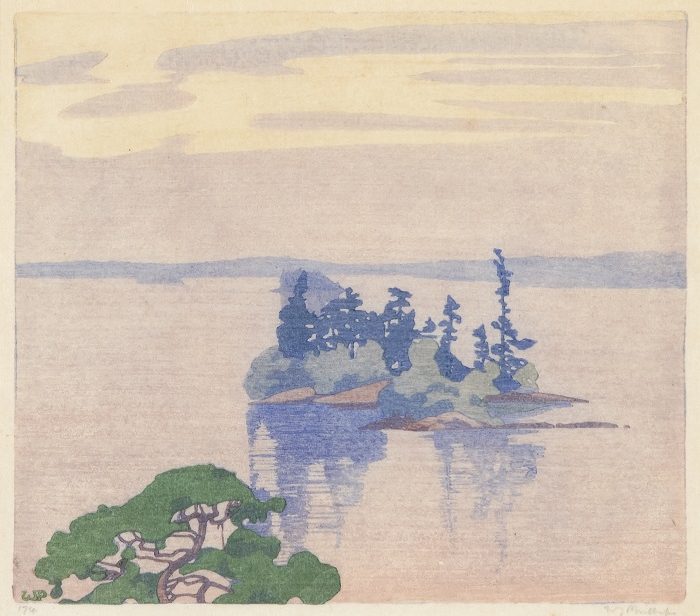
Walter J. Phillips (1884-1963)
Cathcart’s Island, Muskoka, 1927
Colour woodcut on Guya paper
7 1/4″ x 6 1/2″
University of Regina President’s Art Collection, Shumiatcher Donation. Gift of Dr. Morris C. Shumiatcher, O.C., S.O.M., Q.C. and Dr. Jacqui Clay Shumiatcher, S.O.M., C.M., 2016; sc.2016.97
Photograph by the University of Regina
Walter J. Phillips was born in 1884 and is famous for his expertise in watercolor, woodcut, and printmaking. His technical achievements in this medium were inspired by his time spent in the unique Precambrian shield landscape in Northwest Ontario.
The woodcut uses the form of watercolor inks, and the cool tone sets off the ease of the whole painting. Phillips made more people realize the existence and appeal of watercolor inks through his combination of Japanese prints and popular British art.
Phillips relates his life experience to his works of art. According to Phillips, by the lake: “his experience gives him a sense of belonging to his new home. He will create quiet, subtle, and quiet works to capture the unique terrain of the region. Also, he will combine his artworks with the graphic language of Japanese prints and British art.” (Desk).
It can be seen from the painting that Phillips first used watercolor for general positioning, and then used deeper cold colors to outline halo dyeing, combining contemporary art and printmaking. By depicting the trees in the painting and the shadow of the trees standing upside down in the calm lake, the artist draws the impression of his hometown, so as to miss his hometown. Later, through the unique printing technique, we can see that the texture of the picture is very clear and delicate, with an orderly texture.
Jiayuan Yi
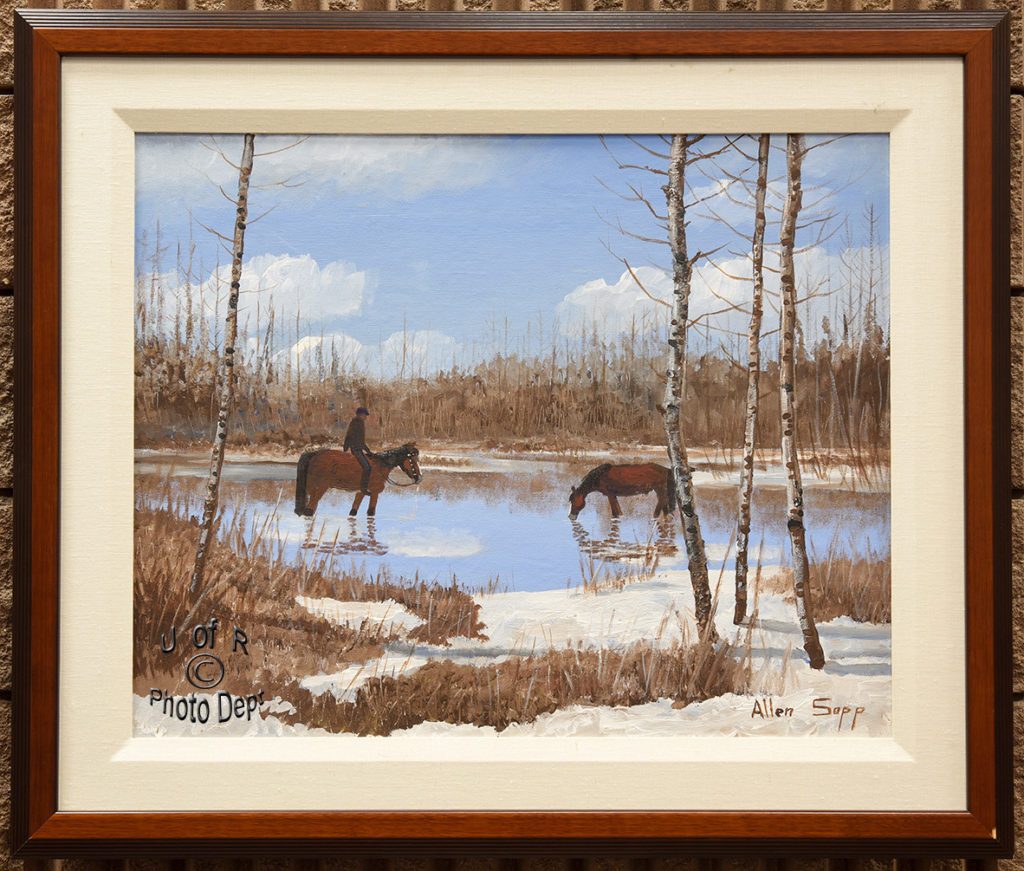
Allen Sapp (1928-2015)
Horses Drinking, c. 1983
Acrylic on canvas
24″ x 30″
University of Regina President’s Art Collection; pc.1998.11
Copyright the Estate of Allen Sapp. Reproduced with permission. Photograph by the University of Regina
Allen Sapp (b. 1928) began his artistic journey as a child, drawing to pass the time as he was kept inside due to illness. With encouragement from his grandmother, Sapp set his sights on making art his career. Moving to North Battleford in 1955, Sapp sold paintings in the streets, the subjects consisting of landscapes that catered to a white audience. One of Sapp’s paintings of a Chief caught the attention of Doctor Allan Gonor, who later acted as Sapp’s adviser. The subject of Sapp’s paintings shifted to that of his Cree upbringing. Sapp created scenes that he had witnessed in his life, in a realistic style.
Horses Drinking (1983) depicts a simple scene with many parts reoccurring throughout Sapp’s works, most notably the winter scene and the involvement of horses. Winter and snow is present through the majority of Sapp’s paintings as it is the season he was born in. Winter also serves as an interesting way to depict Indigenous life on the reserve during the season. The white-covered ground allows for more focus on the horses in the lake. Horses are another subject that appears often in Sapp’s works as they have a long-running relationship with indigenous people and were common labour animals on residences.
Victoria Beahm
Bibliography
LARISSA KITCHEMONIA
Ackerman, Jennifer. “Kêhtê-Ayak: New Teepee Art Installation Brings Indigenous History to Life.” leaderpost. Regina Leader Post, September 13, 2018. https://leaderpost.com/news/local-news/kehte-ayak-new-teepee-art-installation-brings-indigenous-history-to-life.
Atter, Heidi. “Regina Artist Collective Ready to Showcase Indigenous Body Painting at World Festival in Europe | CBC News.” CBCnews. CBC/Radio Canada, June 11, 2019. https://www.cbc.ca/news/canada/saskatchewan/sask-artists-world-festival-indigenous-body-painting-1.5170531.
LaPlante, Brianna, and Emily of Fifth Parallel Gallery. Fifth Parallel Gallery: Anuhkimo! Make Them Dance! Personal, October 27, 2021.
LaPlante, Brianna, and Larissa Kitchemonia. Saturday Night Pow Wow Artist Interview. Personal, October 25, 2021.
“Larissa Kitchemonia.” Campus Art Guide: Larissa Kitchemonia. University of Regina President’s Art Collection. Accessed October 1, 2021. https://www2.uregina.ca/president/art/college-avenue-campus/larissa-kitchemonia/.
MARIE LANNOO
Nasgaard, R., View recent articles by Roald Nasgaard, Chaisson, C., Ekins, R., Crocker, E., Speed, M., & Presented by Cowley Abbott. (n.d.). Marie Lannoo. Canadian Art. Retrieved November 2, 2021, from https://canadianart.ca/reviews/marie-lannoo-mendel/.
About the artist. Marie Lannoo: the architecture of colour – Art Galleries – University of Saskatchewan. (n.d.). Retrieved November 3, 2021, from https://artsandscience.usask.ca/galleries/exhibitions/2019/Marie-Lannoo-the-architecture-ofcolour.php.
Zurevinski, K. (2021, November 2). Marie Lannoo. BlackFlash Magazine. Retrieved November 01, 2021, from https://blackflash.ca/2019/09/20/marie-lannoo/.
ERNEST LINDNER
Burke, Lora. “Lindner’s Works at Rosemont.” The Leader Post (1930-2010), May 10, 1978. Accessed September 27, 2021. https://login.libproxy.uregina.ca:8443/login?url=https://www-proquest-com.libproxy.uregina.ca/historical-newspapers/may-10-1978-page-80-92/docview/2218048689/se-2?accountid=13480. 80
“Ernest Lindner.” Saskatchewan Network for Art Collecting (NAC). Accessed September 27, http://www.sknac.ca/index.php?page=ArtistDetail&id=85.
“Ernest Lindner.”. Star-Phoenix (1967-2009), May 26, 2006. Accessed September 27, 2001.
https://login.libproxy.uregina.ca:8443/login?url=https://www-proquestcom.libproxy.uregina.ca/historical-newspapers/may-26-2006-page-77-151/docview/2345188412/se-2?accountid=13480. 77.
Gidluck, Lynn. “Unparalleled Access to the Arts: The History of the Organization of Saskatchewan Arts Councils.” Prairie History, no. 4 (2021): 36+. Gale Academic OneFile Select (accessed September 27, 2021). https://link.gale.com/apps/doc/A664140244/EAIM?u=ureginalib&sid=bookmark-EAIM&xid=a487e0c4.
Hale, Barrie. “You Don’t Put Clothes on Trees: Ernest Lindner’s long journey of self discovery.” The Gazette (1867-2010), Nov 27, 1976. Accessed September 27, 2021 https:// login.libproxy.uregina.ca:8443/login?url=https://www-proquestcom.libproxy.uregina.ca/historical-newspapers/november-27-1976-page-62-162/docview/2199049523/se-2?accountid=13480. 62-65.
Heath, Terrence. Uprooted: the Life and Art of Ernest Lindner. Saskatoon: Fifth House, 1983.
Jackson, Paul. “Renowned City Artist Ernest Lindner Dead.” Star-Phoenix (1967-2009), Nov 08, September 26, 2021. https://login.libproxy.uregina.ca:8443/loginurl=https://wwwproquest.com.libproxy.uregina.ca/historical-newspapers/november-8-1988-page-3-44/docview/2344874424/se-2?accountid=13480. 3.
Lindner, Degen. Personal communication by phone to author, October 16, 2021.
Lindner, Ernest, “Dead Fall #2 (41/100)” Lithograph, 1976, University of Regina President’s Art Collection.
“Two-man Show at the Art Centre.” The Saskatoon Star-Phoenix (1928-1967), Feb 16, 1954. September 26, 2021. https://login.libproxy.uregina.ca:8443/login?url=https://wwwproquest-
com.libproxy.uregina.ca/historical-newspapers/february-16-1954-page-3-18/ docview/2343669501/se-2?accountid=13480. 3
ZACHARI LOGAN
Bessai, Margaret. Zachari Logan: A Natural History of Unnatural Things. Regina: Art Gallery of Regina, October 2015. Published following the exhibition Zachari Logan: A Natural History of Unnatural Things. Zachari Logan: A Natural History of Unnatural Things at The Art Gallery of Regina.
Borderviews. “Feat of Clay.” Border Crossings, May 2015, bordercrossingsmag.com/article/feat-of-clay1
Logan, Zachari. A Natural History of Unnatural Things. Regina: Radiant Press, 2021.
Whyte, Murray. “Art Fair Seeks to Redefine Itself.” Toronto Star 2016.
Wolin, Joseph R. “Ross Bleckner and Zachari Logan.” Border Crossings, March 2019, bordercrossingsmag.com/article/ross-bleckner-and-zachari-logan
“Zachari Logan.” Dunlop Art Gallery. Accessed November 16, 2021. http://collection.dunlopartgallery.org
NORVAL MORRISSEAU
Bearclaw Gallery. “Norval Morrisseau Prints,” Bearclaw Gallery, Accessed November 3, 2021, https://bearclawgallery.com/artists/norval-morrisseau-tree-of-life-exhibition-2017/.
La Boutique Boréal. “Loon Family by Norval Morrisseau Matted.” Boutique Boreal. Accessed October 6, 2021.
https://www.boutiqueboreale.com/us/loon-family-by-norval-morrisseau-matted.html. McMichael Canadian Art Collection. “Morrisseau at the McMichael.” McMichael. Accessed October 5, 2021. https://mcmichael.com/event/morrisseau-at-the-mcmichael/.
Native Art in Canada. “Norval Morrisseau,” Native Art in Canada, accessed November 3, 2021, https://www.native-art-in-canada.com/norvalmorrisseau.html.
New World Encyclopedia contributors, “Joseph, son of Jacob,” New World Encyclopedia, accessed November 3, 2021, https://www.newworldencyclopedia.org/p/index.php?title=Joseph,_son_of_Jacob&oldid=1017043.
O’Connor, D. William. “St. Peter the Apostle.” Encyclopedia Britannica, August 20, 2020. https://www.britannica.com/biography/Saint-Peter-the-Apostle. Read, Marie. “Spirit of the North: The Common Loon,” All About Birds, April 15, 2008, https://www.allaboutbirds.org/news/spirit-of-the-north-the-common-loon/.
Rempel, Zachary. An Anishinaabe Ethno-ornithology of Wabaseemoong Independent Nations, Manitoba: University of Manitoba, 2019. Pdf: https://umanitoba.ca/institutes/natural_resources/pdf/2020/Masters%20Thesis%20Rempel%202020.pdf.
Robertson, Carmen, “Norval Morrisseau Life & Work,” Art Canada Institute, 2016, https://www.aci-iac.ca/art-books/norval-morrisseau/.
WALTER J. PHILLIPS
Desk, Admissions. “Walter J. Phillips: At the Lake.” McMichael Canadian Art Collection. Accessed November 16, 2021. https://mcmichael.com/event/wj-phillips/.
“Walter Joseph (W.J.) Phillips | Loch Gallery.” www.lochgallery.com. Accessed November 15, 2021. https://www.lochgallery.com/artist/walter-joseph-wj-phillips.
ALLEN SAPP
Black, Joan. “Grandmother believed in boy’s artistic talent: Allen Sapp.” Windspeaker, April 1999, 1(suppl). Gale In Context: Canada. https://link.gale.com/apps/doc/A30540152/CIC?u=ureginalib&sid=bookmark-CIC&xid=25ec1205.
Bauche, Dean. “Sapp, Allen.” Indigenous Saskatchewan Encyclopedia. University of Saskatchewan. https://teaching.usask.ca/indigenoussk/import/sapp_allen_1929-.php
Beavon, Daniel J. K., Cora Jane Voyageur, and David Newhouse. Hidden in Plain Sight: Contributions of Aboriginal Peoples to Canadian Identity and Culture. University of Toronto Press, 2005, pages 188-190. https://books.scholarsportal.info/uri/ebooks/ebooks2/utpress/2013-08-26/1/9781442688230
Garven, Leah. “The Life and Art of Allen Sapp.” Allen Sapp Gallery: The Gonor Collection. https://www.allensapp.com/about/the_life_and_art_of_allen_sapp.html
Meili, Dianne. “Allen Sapp Cree artist captured prairie life.” Windspeaker, February 2016, 26. Gale In Context: Canada. https://books.scholarsportal.info/uri/ebooks/ebooks2/utpress/2013-08-26/1/9781442688230.


